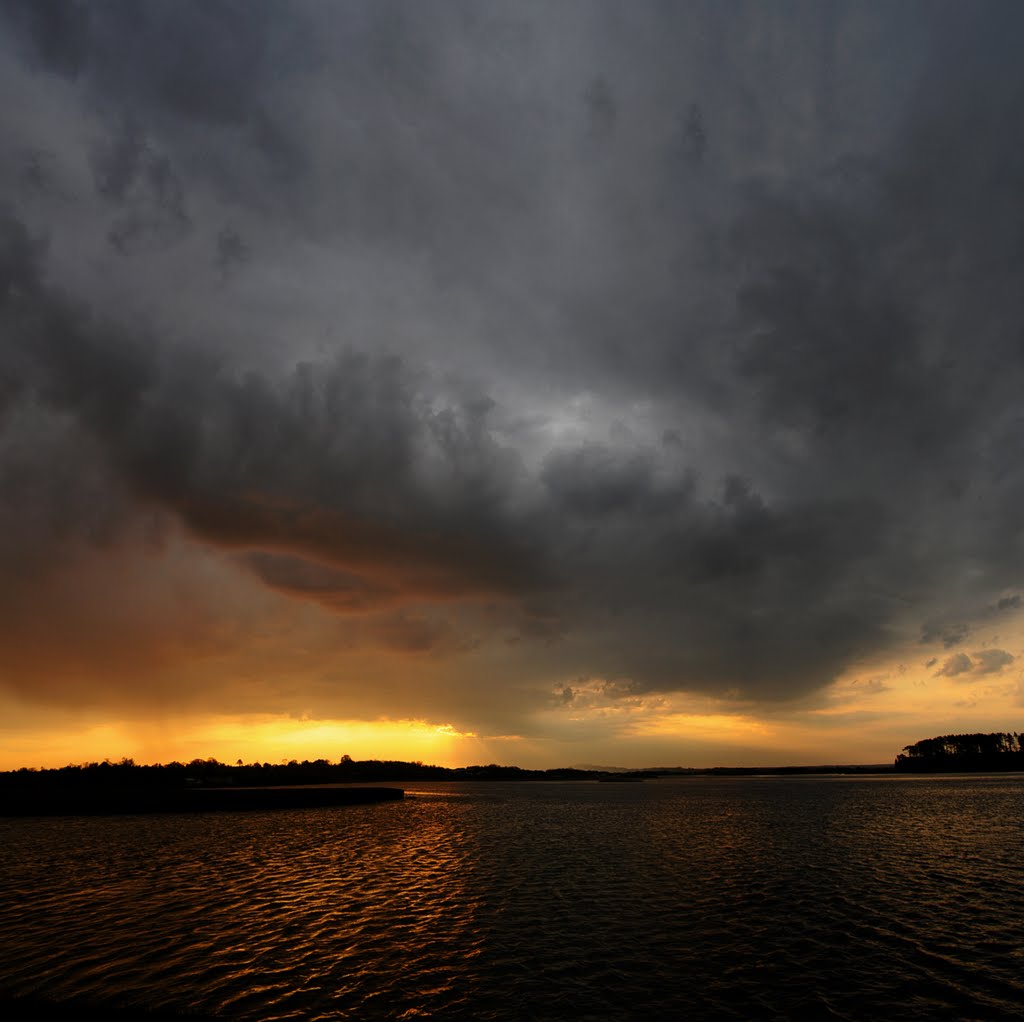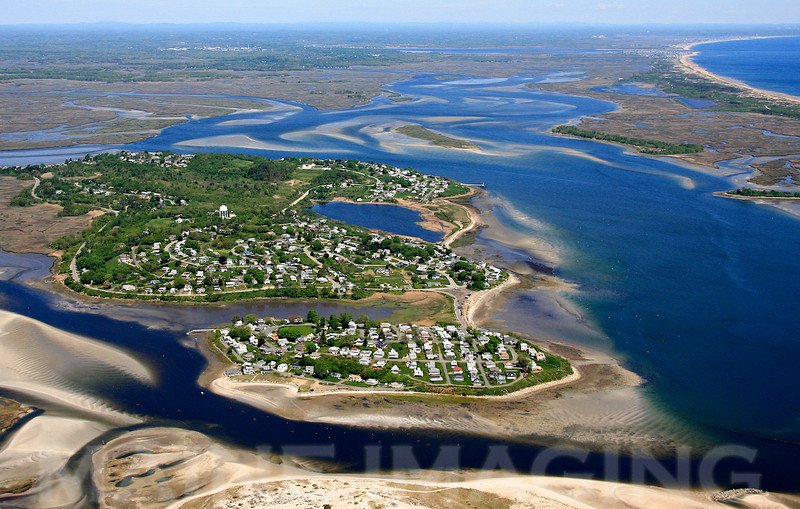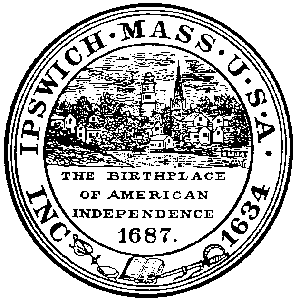Difference between revisions of "Ipswich"
(→Attractions) |
(→Supernatural Ipswich) |
||
| Line 169: | Line 169: | ||
== '''Supernatural Ipswich''' == | == '''Supernatural Ipswich''' == | ||
| − | + | === [[Sa-Nefer-Khepre]] === | |
| − | + | [[]] | |
| − | + | <br> | |
| + | <br> | ||
| + | ---- | ||
| + | <br> | ||
| + | <br> | ||
| + | === [[Ezra Winthrop]] === | ||
| + | [[]] | ||
| + | <br> | ||
| + | <br> | ||
| + | ---- | ||
| + | <br> | ||
| + | <br> | ||
| + | === [[Nathaniel Winthrop]] === | ||
| + | [[]] | ||
| + | <br> | ||
| + | <br> | ||
| + | ---- | ||
| + | <br> | ||
| + | <br> | ||
== '''Websites''' == | == '''Websites''' == | ||
Revision as of 12:55, 31 July 2015
Contents
- 1 Quote
- 2 Appearance
- 3 City Device
- 4 Climate
- 5 Districts
- 6 Demonym
- 7 Economy
- 8 Geography
- 9 History
- 10 Population
- 11 Arenas
- 12 Attractions
- 13 Banks
- 14 Bars and Clubs
- 15 Cemeteries
- 16 City Government
- 17 Crime
- 18 Citizens of the City
- 19 Current Events
- 20 Fortifications
- 21 Galleries
- 22 Holy Ground
- 23 Hospitals
- 24 Hotels & Hostels
- 25 Landmarks
- 26 Mass Media
- 27 Monuments
- 28 Museums
- 29 Parks
- 30 Private Residences
- 31 Restaurants
- 32 Ruins
- 33 Schools
- 34 Shopping
- 35 Telecommunications
- 36 Theaters
- 37 Transportation
- 38 Supernatural Ipswich
- 39 Websites
Quote
"Searchers after horror haunt strange, far places. For them are the catacombs of Ptolemais, and the carven mausolea of the nightmare countries. They climb to the moonlit towers of ruined Rhine castles, and falter down black cobwebbed steps beneath the scattered stones of forgotten cities in Asia. The haunted wood and the desolate mountain are their shrines, and they linger around the sinister monoliths on uninhabited islands. But the true epicure of the terrible, to whom a new thrill of unutterable ghastliness is the chief end and justification of existence, esteem most of all the ancient, lonely farmhouses of backwoods New England; for there the dark elements of strength, solitude, grotesqueness, and ignorance combine to form the perfection of the hideous." -- H. P. Lovecraft excerpt from The Picture in the House (1920)
Appearance
City Device
Climate
Districts
Demonym
Economy
Geography
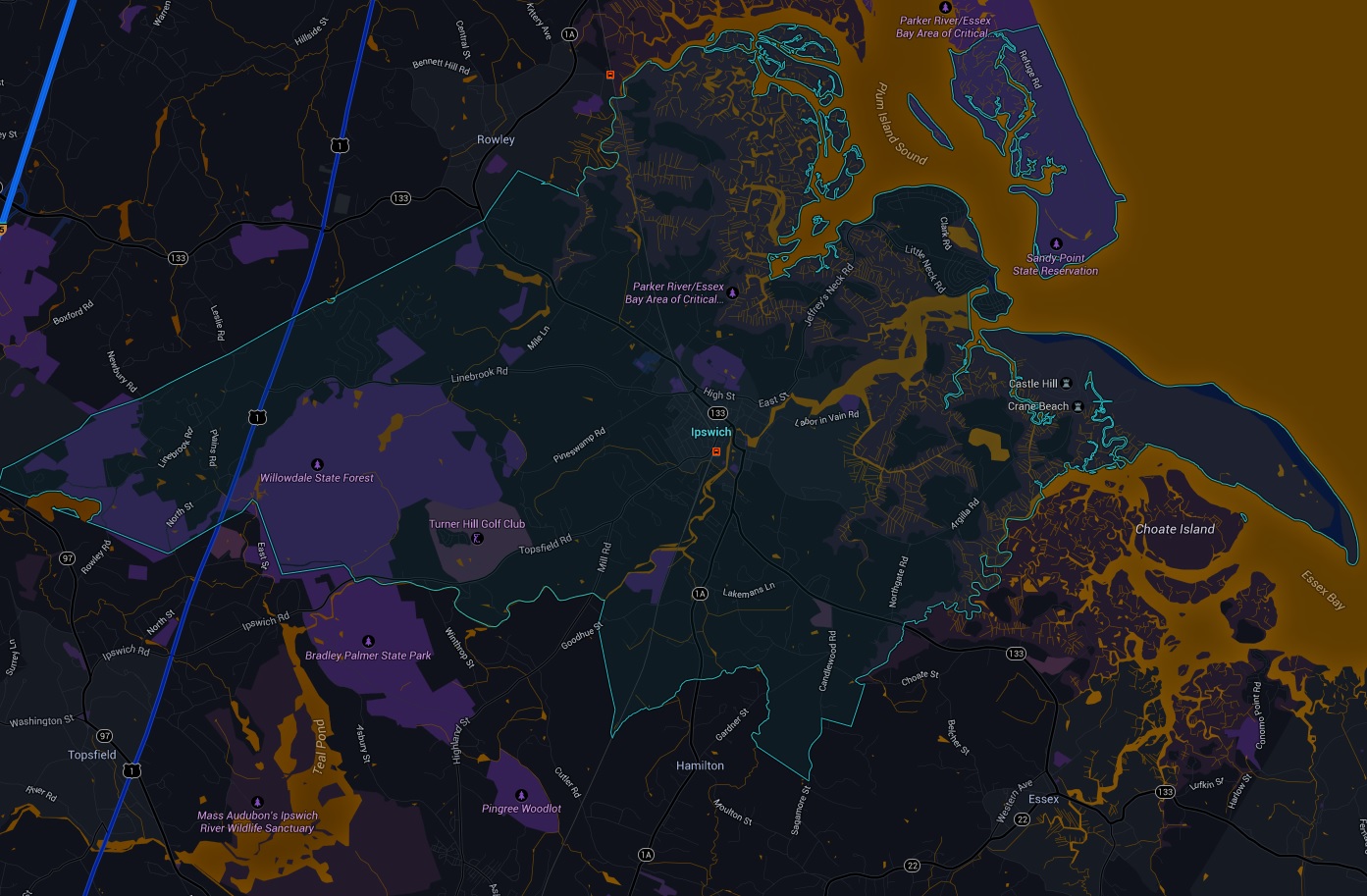
Ipswich is drained by the Ipswich River and Plum Island Sound, which join at their mouths and empty through a narrow but navigable channel at the foot of Castle Hill around Sandy Point into Ipswich Bay adjoining the Atlantic Ocean. The southern portion of Plum Island falls within the area allotted to the town, making up the town's ocean shore along with Castle Neck, south of the Sound. The northeastern part of town is marshy, where the Rowley River, Roger Island River, and Eagle Hill River drain into Plum Island Sound. South of Castle Neck, the Castle Neck River separates the town from neighboring Essex. A large portion of the western end of town is dominated by Willowdale State Forest, and other portions of the town are also protected land, including Crane Wildlife Refuge on Castle Neck, the Parker River National Wildlife Refuge and Sandy Point State Reservation on Plum Island, as well as Hamlin Reservation, Heartbreak Hill Reservation, Bull Brook Reservoir, Greenwood Farm and a portion of Appleton Farms Sanctuary, which extends into Hamilton.
Ipswich is located in central Essex County and is 11 miles (18 km) south of Newburyport, 12 miles (19 km) northwest of Gloucester, 13 miles (21 km) north of Salem, 20 miles (32 km) east of Lawrence, and 28 miles (45 km) northeast of Boston. It is bordered by Rowley to the north, Boxford to the west, and Topsfield, Hamilton, Essex and Gloucester to the south. (The border with Gloucester lies across Essex Bay, and as such there is no land connection between the two.)
History
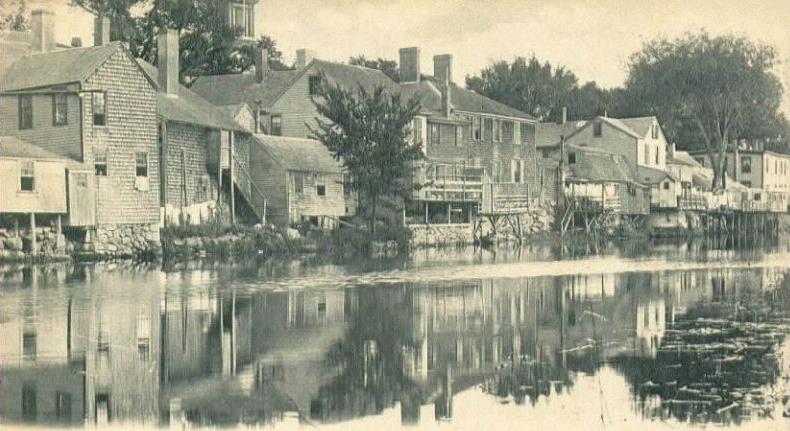
Ipswich was founded by John Winthrop the Younger, son of John Winthrop, one of the founders of the Massachusetts Bay Colony in 1630 and its first governor, elected in England in 1629. Several hundred colonists sailed from England in 1630 in a fleet of 11 ships, including Winthrop's flagship, the Arbella. Investigating the region of Salem and Cape Ann, they entertained aboard the Arbella for a day, June 12, 1630, a native chief of the lands to the north, Chief Masconomet. The event was recorded in Winthrop's journal on the 13th, but Winthrop did not say how they overcame the language barrier. The name they heard from Masconomet concerning the country over which he ruled has been reconstructed as Wonnesquamsauke, which the English promptly rendered into the anglicized "Agawam". The colonists, however, sailed to the south where some buildings had already been prepared for them at a place newly named Charlestown.
That winter they lost a few hundred colonists from malnutrition and disease. They also experienced their first nor'easter, which cost them some fingers and toes, as well as houses destroyed by the fires they kept burning day and night. Just as Winthrop was handing out the last handful of grain, the supply ship Lyon entered Boston Harbor. John now sent for his family in England, but his then wife, Margaret, her children, and his eldest son, John, whose mother was the elder John's first wife, Mary Forth, did not arrive until November, on the Lyon.
John the Younger resided with his father and stepmother until 1633, when he resolved to settle in Agawam, with the permission of the General Court of Massachusetts. Captain John Smith had written about the Angoam or Aggawom region in 1614, referring to it as "an excellent habitation, being a good and safe harbour." There is no record of any native resistance to the colonization either at Charlestown or at Agawam, even though estimates of the earlier populations run into the thousands. A plague of 1616–1618 and again in the early 1630s, perhaps smallpox brought from abroad, had apparently devastated the once populous Indian tribes. The fields stood vacant. The colonists encountered but few natives.
John the Younger and 12 men aboard a shallop sailed into Ipswich harbor and took up residence there. Two men continued up the river (now River Road) to a large meadow, which they called New Meadows, now Topsfield. Agawam was incorporated on August 5, 1634, as Ipswich, after Ipswich in the county of Suffolk, England. The name "Ipswich" was taken "in acknowledgment of the great honor and kindness done to our people which took shipping there." Nathaniel Ward, an assistant pastor in town from 1634 to 1636, wrote the first code of laws for Massachusetts and later published the religious/political work, The Simple Cobbler of Aggawam in America in England.
The pioneers would become farmers, fishermen, shipbuilders or traders. The tidal Ipswich River provided water power for mills, and salt marshes supplied hay for livestock. A cottage industry in lace-making developed. But in 1687, Ipswich residents, led by the Reverend John Wise, protested a tax imposed by the governor, Sir Edmund Andros. As Englishmen, they argued, taxation without representation was unacceptable. Citizens were jailed, but then Andros was recalled to England in 1689, and the new British sovereigns, William and Mary, issued colonists another charter. The rebellion is the reason the town calls itself the "Birthplace of American Independence".
Great clipper ships of the 19th century, however, bypassed Ipswich in favor of the deep-water seaports at Salem, Newburyport, Quincy, and Boston. The town remained primarily a fishing and farming community, its residents living in older homes they could not afford to replace—leaving Ipswich with a considerable inventory of early architecture. In 1822, a stocking manufacturing machine which had been smuggled out of England arrived at Ipswich, violating a British ban on exporting such technology, and the community developed as a mill town. In 1828, the Ipswich Female Seminary was founded. In 1868, Amos A. Lawrence established the Ipswich Hosiery Mills beside the river. It would expand into the largest stocking mill in the country by the turn of the 20th century. What may be the last witchcraft trial in North America was held in Ipswich in 1878. In the Ipswich witchcraft trial, a member of the Christian Science religion was accused of using his mental powers to harm others, including a spinster living in the town.
The town government was reformed in 1950 with the acceptance of the Town Manager Charter. This charter was rescinded by the voters, regained, lost again, and the present Town Manager-Selectmen Charter was adopted by the voters in 1967.
In 1910, Richard T. Crane, Jr. of Chicago, the business magnate owner of Crane Plumbing, bought Castle Hill, a drumlin on Ipswich Bay. He hired Olmsted Brothers, successors to Frederick Law Olmsted, to landscape his 3,500-acre (14 km2) estate, and engaged the Boston architectural firm of Shepley, Rutan & Coolidge to design an Italian Renaissance-Revival style villa on the summit. A grande allée, 160 feet (49 m) wide and lined with statuary, would run the half mile from house to sea. But his wife, Florence, loathed the building. Crane promised that if she still didn't like it in 10 years, he would replace it. True enough, in 1928 a new 59-room mansion designed by Chicago architect David Adler in the English Stuart style stood in its place, called the Great House. At Mrs. Crane's death in 1949, the entire property was bequeathed to The Trustees of Reservations, which uses it as a venue for concerts and weddings.
Population
- -- Town (14,571) - 3034 census -- The racial makeup of the town is 97.60% White.
Arenas
Attractions
- -- Appleton Farms (1638)
- -- Brown Stocking Mill Historic District
- -- Choate Bridge (1764)
- -- Crane Beach
- -- Ipswich Historical Society (c. 1800)
- -- John Whipple House (1642/1677)
- -- South Green Historic District (Ipswich, Massachusetts)
- --
- --
- --
- --
Banks
- -- Institution for Savings
Bars and Clubs
- -- Choate Bridge Pub
- -- Mercury Brewing Company (Ipswich Ale Brewery)
- -- SALT Kitchen & Rum Bar
- -- Zumi’s Espresso
Cemeteries
- -- Highland Cemetery
- -- Locust Grove Cemetery
- -- Old South Cemetery
Funeral Homes
- -- Morris Funeral Home, Inc.
- -- Whittier-Porter Funeral Home
City Government
- -- Ipswich Fire Department
- -- Ipswich Police Department
- -- Ipswich Post Office
- -- Ipswich Public Library
- -- Ipswich Town Hall
- -- Ipswich Visitors Center (Hall-Haskell House)
Crime
Citizens of the City
Current Events
Fortifications
Galleries
Holy Ground
- -- First Church in Ipswich (North Town Green)
- -- Ipswich United Methodist Church
Hospitals
Hotels & Hostels
- -- Ipswich Bed & Breakfast
- -- Kaede Bed & Breakfast
Landmarks
Mass Media
- -- Ipswich Chronicle
Monuments
Museums
- -- Heard House Museum (Ipswich Museum)
- -- Ipswich Historical Commission
Parks
- -- Crane Beach
- -- Father Rye Park
- -- North Town Green
- -- South Village Green
- -- Plum Island (Massachusetts)
- -- Sandy Point State Reservation
- -- Willowdale State Forest
Private Residences
Restaurants
Ruins
Schools
Elementary schools
- -- Paul F. Doyon Elementary
- -- Winthrop Elementary School
Middle and high schools
The middle school and high school are housed in the same building and share the library, the cafeteria, performing arts facilities and athletic resources (tennis courts, a baseball diamond, a football field, and a running track).
Ipswich High School (IHS) has been considered one of the best public high schools in the Boston area.[citation needed] The Ipswich Public Schools also have what is considered one of the best performing arts programs. In 2005, the high school was named a "Blue Ribbon" school. The Blue Ribbon is an award for national excellence in education under the No Child Left Behind legislation. The school also received a Vanguard award for similar academic prowess. IHS offers college-prep, honors, and AP-level classes. IHS has one of the highest graduation rates in Massachusetts.
Ipswich Middle/High School is considered to have one of the best music programs in the state. It contains choruses, bands (including jazz, pep and concert bands), orchestra and symphony orchestra. There are also plans to integrate dance into the program in the near future.
The high school mascot is the Tiger, and the school colors are orange and black. Ipswich competes in the Cape Ann League. The high school football team won the Division 3A Super Bowl Championship in 2006. It was the school's first title since 1992, and the fifth in school history. (Previous titles were achieved in 1974, 1977, 1991, and 1992.) Ipswich's traditional rival is Hamilton-Wenham Regional High School.
- -- Ipswich Middle School
- -- Ipswich High School
Shopping
- -- Liberty Coin
Telecommunications
Theaters
Transportation
There is no interstate highway which runs through Ipswich; Interstate 95 passes through neighboring Boxford and Topsfield. U.S. Route 1, known as the Newburyport Turnpike, passes through the western end of town. Massachusetts Route 1A and Route 133 pass through the town, entering concurrently from Rowley and passing through the center of town before splitting south of the town center; Route 1A heads towards Hamilton and Beverly, while Route 133 leads to Essex and Gloucester.
Ipswich has a station along the Newburyport/Rockport Line of the MBTA Commuter Rail, providing service between Newburyport and Boston's North Station. There is no air service within town; the nearest small airports are in Newbury and Beverly, and the nearest national service is Boston's Logan International Airport. The Ipswich Essex Explorer provides summertime weekend shuttle service connecting Ipswich MBTA train station with Crane Beach, Essex and Appleton Farms.
Supernatural Ipswich
Sa-Nefer-Khepre
[[]]
Ezra Winthrop
[[]]
Nathaniel Winthrop
[[]]
Websites
https://en.wikipedia.org/wiki/Ipswich,_Massachusetts
http://old.wikimapia.org/#lat=42.6910412&lon=-70.8327902&z=13&l=0&m=b&v=8
